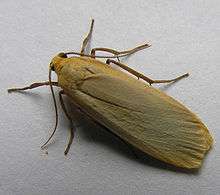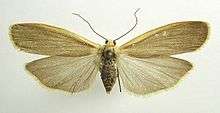Katha depressa
| Katha depressa | |
|---|---|
 | |
 | |
| Scientific classification | |
| Kingdom: | Animalia |
| Clade: | Euarthropoda |
| Class: | Insecta |
| Order: | Lepidoptera |
| Superfamily: | Noctuoidea |
| Family: | Erebidae |
| Genus: | Katha |
| Species: | K. depressa |
| Binomial name | |
| Katha depressa | |
| Synonyms | |
| |
The buff footman (Katha depressa or Katha deplana) is a moth of the family Erebidae. It is found from western Europe east through the Palearctic (northern Asia Minor, Crimea, Abkhazia, Transcaucasia, southern Siberia, Middle Amur, Primorye, Sakhalin, Kunashir, Zhejiang) to Korea and Japan.
.jpg)
.jpg)
Technical description and variation
The length of the forewings is 15–17 mm. Both wings dark brown grey, with the costa of the forewing and the fringes light bright yellow, especially in the female. The ground colour is often more or less lightened with ochreous, sometimes almost clay-colour (ochreola Hbn.), or nearly whitish (helveola Ochs.) or of an indefinite intermediate shade (luteola Hbn.). In pavescens Butl. from Hokkaido (Island of Yezo), the wings are dirty greyish yellow; the hindwing lighter. [2]
Subspecies
- Katha deplana deplana
- Katha deplana pavescens (Butler, 1877) (Russia: Middle Amur, Primorye, Sakhalin, Kunashir; Korea; Japan)
Biology
The moth flies from June to September depending on the location.
Larva dirty lead grey, bearing a yellow dorsal stripe with dark edges and three raised black transverse spots anteriorly, posteriorly and in the centre, and black markings laterally. The larvae feed on lichen and algae, especially on Pinophyta, but also on oak and Calluna. Until June, on lichens on trees. Pupa glossy red brown. The moths singly but not rare, in July and the beginning of August, may especially be beaten from young conifers.
References
- ↑ Does Eilema Hübner, 1819 (Lepidoptera, Arctiidae, Lithosiinae) present one or several genera?
- ↑ Seitz, E. in Seitz, A. Ed. Die Großschmetterlinge der Erde, Verlag Alfred Kernen, Stuttgart Band 2: Abt. 1, Die Großschmetterlinge des palaearktischen Faunengebietes, Die palaearktischen Spinner und Schwärmer, 1912-1913
| Wikimedia Commons has media related to Eilema depressa. |
| Wikispecies has information related to Katha deplana |
External links
- Funet Eilema Taxonomy
- Eilema depressa on Fauna Europaea
- Eilema depressa on Lepidoptera of Belgium
- Eilema depressa on Lepiforum.de
- Eilema depressa on Vlindernet.nl (in Dutch)